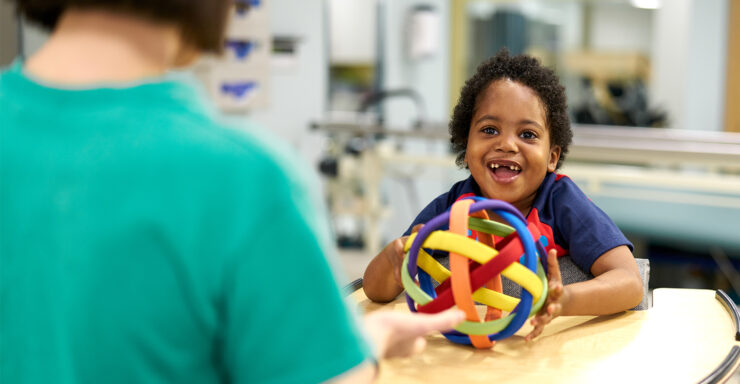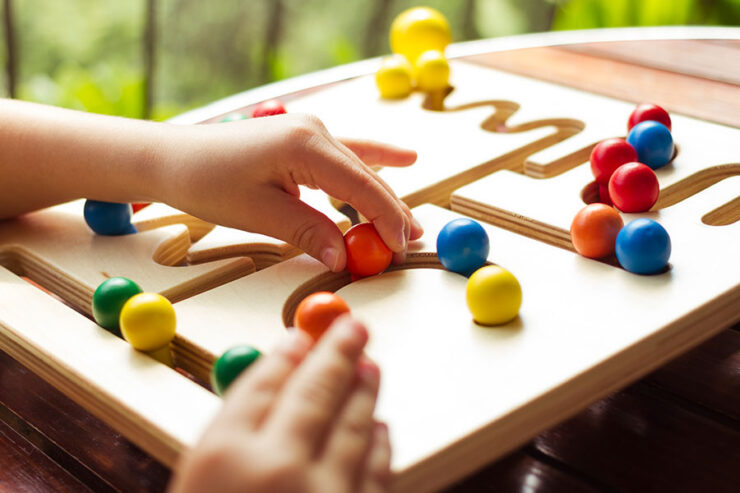Occupational therapy for children
Occupational therapy (OT) for SPD in children is fun! During sensory-based OT sessions, the therapist and your child interact in a sensory-rich environment with lots of swinging, spinning, tactile, visual, auditory, and taste opportunities that seem to a child more like a giant playground than a therapy center. Sessions are subtly structured so your child is challenged but always successful in completing each activity.
When occupational therapy is effective, children improve their ability to accurately detect, regulate, interpret, and execute appropriate motor and behavioral responses to sensations so they are able to perform everyday “occupations” in a functional manner. These occupations include playing with friends, enjoying school or work, completing daily routines such as eating, dressing, sleeping, and enjoying typical family life.
During the course of treatment, the therapist continually evaluates each child’s abilities in several areas summarized as “A SECRET” in Sensational Kids, Dr. Lucy Jane Miller’s definitive book on Sensory Processing Disorder in children.

- Attention: Is there a way to enhance sustained or divided attention to people and activities around the child?
- Sensation: Is there a way to modify the child’s responses to sensory input?
- Emotion: What emotion is the child experiencing, and can these emotions be regulated?
- Culture: What part of the family’s culture (habits and routines) can be changed to avoid challenging situations?
- Relationship: Is there something in the relationships experienced by the child that is causing his or her responses? For example, does the child need closer support or need more space?
- Environment: What in the environment is not optimal for the child? How can those environmental factors be modified?
- Task: What is troubling the child or difficult about the task at hand? How can the task be modified so that it is not so problematic?
In other words, the focus in therapy and in natural settings when sensory challenges occur is to first examine the factors contributing to the observed challenge and second, to modify or use the other “SECRET” factors to affect the problem area.
The goal of OT for children is always on developing automatic and appropriate responses to sensation so that daily occupations can be competently performed and social participation fostered. As these competencies increase with effective treatment, social participation, self-esteem, self-regulation, and sensorimotor abilities also increase, and other family goals and priorities are achieved
A more extensive explanation of the A SECRET treatment model may be found in Sensational Kids: Hope and Help for Children With Sensory Processing Disorder by Lucy Jane Miller, PhD, OTR.
Occupational therapy for adults

A growing body of scientific research suggests that the human brain remains capable of change and adaptation into old age. What this means for adults and older children with SPD is that they, too, can benefit from the intervention for their sensory challenges.
Effective services for adults and older adolescents include direct therapy, home programs, education, and/or accommodations.
In direct treatment, therapy is designed to improve sensory processing and decrease sensory symptoms. Specific sensory inputs such as tactile stimulation, movement, auditory input, and/or other sensory experiences are utilized to reduce the client’s specific symptoms. Adults who have never before experienced heights, touch, or movement with comfort can become much more successful and happy during those activities.
Home programs can also be utilized, with or without regular direct treatment, to assist with reducing the negative symptoms associated with SPD. Education about SPD and the sensory systems can contribute to an individual developing insight into how sensory processing differences affect learning, relationships, and social participation. The understanding that results lays the foundation for developing accommodations to sensory-based differences and helping to reduce the negative impact of SPD on daily life.
Because brain plasticity diminishes throughout life, adults and older children may progress more slowly in treatment than young children, but improvement is achievable at any stage of life with effective therapeutic intervention.

